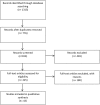Fluoroquinolone-Resistant Enteric Bacteria in Sub-Saharan Africa: Clones, Implications and Research Needs
- PMID: 27148238
- PMCID: PMC4841292
- DOI: 10.3389/fmicb.2016.00558
Fluoroquinolone-Resistant Enteric Bacteria in Sub-Saharan Africa: Clones, Implications and Research Needs
Abstract
Fluoroquinolones came into widespread use in African countries in the early 2000s, after patents for the first generation of these drugs expired. By that time, quinolone antibacterial agents had been used intensively worldwide and resistant lineages of many bacterial species had evolved. We sought to understand which Gram negative enteric pandemic lineages have been reported from Africa, as well as the nature and transmission of any indigenous resistant clones. A systematic review of articles indexed in the Medline and AJOL literature databases was conducted. We report on the findings of 43 eligible studies documenting local or pandemic fluoroquinolone-resistant enteric clones in sub-Sahara African countries. Most reports are of invasive non-typhoidal Salmonella and Escherichia coli lineages and there have been three reports of cholera outbreaks caused by fluoroquinolone-resistant Vibrio cholerae O1. Fluoroquinolone-resistant clones have also been reported from commensals and animal isolates but there are few data for non-Enterobacteriaceae and almost none for difficult-to-culture Campylobacter spp. Fluoroquinolone-resistant lineages identified in African countries were universally resistant to multiple other classes of antibacterial agents. Although as many as 972 non-duplicate articles refer to fluoroquinolone resistance in enteric bacteria from Africa, most do not report on subtypes and therefore information on the epidemiology of fluoroquinolone-resistant clones is available from only a handful of countries in the subcontinent. When resistance is reported, resistance mechanisms and lineage information is rarely investigated. Insufficient attention has been given to molecular and sequence-based methods necessary for identifying and tracking resistant clones in Africa and more research is needed in this area.
Keywords: Africa; Campylobacter; Escherichia coli; Salmonella; Vibrio cholerae; antimicrobial resistance; fluoroquinolone resistance; quinolone resistance.
Figures
References
-
- Ahmed A. A., Osman H., Mansour A. M., Musa H. A., Ahmed A. B., Karrar Z., et al. . (2000). Antimicrobial agent resistance in bacterial isolates from patients with diarrhea and urinary tract infection in the Sudan. Am. J. Trop. Med. Hyg. 63, 259–263. - PubMed
-
- Aibinu I., Aednipedun E., Odugbemi T. (2004). Emergence of quinolone resistance amongst Escherichia coli strains isolated from clinical infections in some Lagos state hospitals in Nigeria. Niger. J. Health Biomed. Sci. 3, 73–78. 10.4314/njhbs.v3i2.11513 - DOI
Publication types
Grants and funding
LinkOut - more resources
Full Text Sources
Other Literature Sources
Molecular Biology Databases
Miscellaneous


